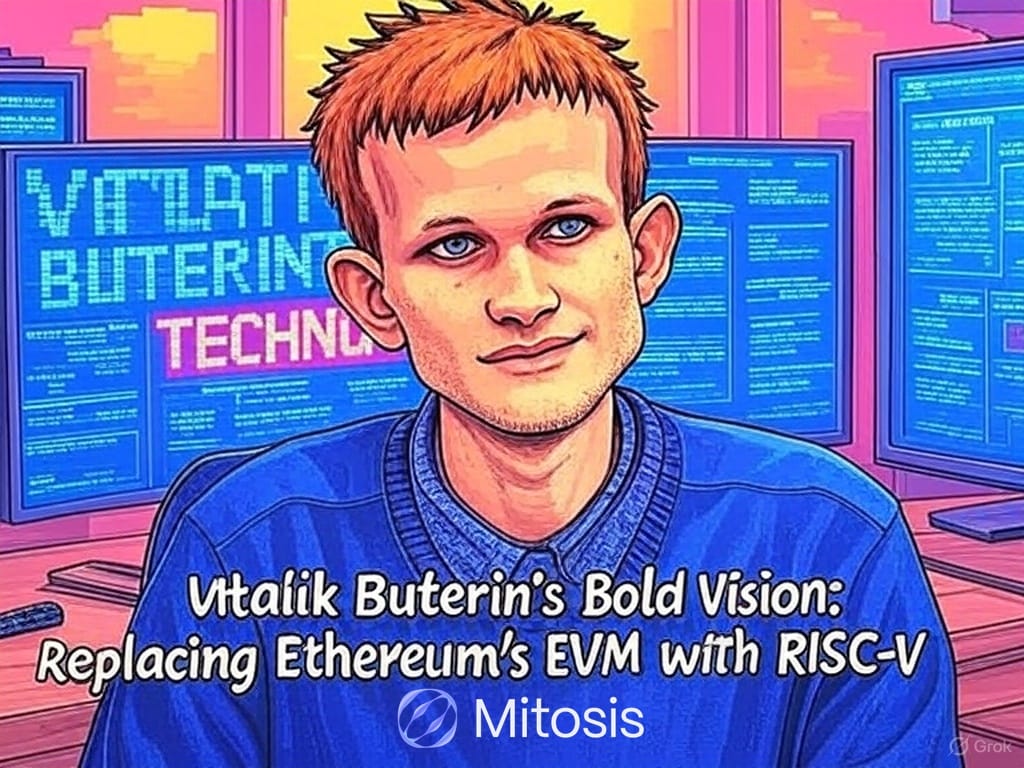Vitalik Buterin’s Bold Vision: Replacing Ethereum’s EVM with RISC-V

Introduction
Ethereum co-founder Vitalik Buterin has proposed a revolutionary shift in Ethereum’s execution architecture: replacing the Ethereum Virtual Machine (EVM) with the open-source RISC-V instruction set. This radical change aims to future-proof Ethereum by making it more scalable, efficient, and optimized for zero-knowledge proofs (ZKPs).
This article explores the motivations behind Vitalik’s proposal, compares EVM vs. RISC-V, analyzes potential benefits and challenges, and discusses the broader implications for the Ethereum ecosystem.
The Background: Why Now?
Ethereum has been steadily evolving from its proof-of-work origins into a highly modular and scalable network.
With major upgrades like The Merge and EIP-4844 (Proto-Danksharding), Ethereum’s focus has shifted toward long-term scalability and reducing transaction costs.
Yet, the EVM, which interprets and executes smart contract code, has remained largely unchanged at its core.
Designed in 2014, the EVM is relatively limited compared to modern execution environments. It was created for a nascent blockchain world — not for today's demands where millions of users, complex dApps, and ZK proofs dominate the landscape.
Challenges with the current EVM:
- Inefficient for complex computation.
- Not optimized for generating ZK proofs.
- Limited support for high-level optimizations.
- Difficult to implement efficient, verifiable execution at scale.
Given Ethereum’s ambition to remain the world’s settlement layer, modernizing its execution environment is essential.
Vitalik’s Proposal: Ethereum Meets RISC-V
Vitalik proposes replacing the EVM’s custom bytecode and execution logic with RISC-V, an open standard, widely adopted instruction set architecture (ISA).
Key points of the proposal:
- Efficiency Boost:
RISC-V can improve execution efficiency by up to 100x in ZK proof generation and general computation. - Compatibility Layer:
To avoid breaking existing dApps, Ethereum would retain backward compatibility, possibly through an interpreter layer. - Better Tooling and Optimization:
Developers could leverage mature compilers, optimizers, and ZK circuits built for RISC-V, streamlining development and verification. - Open-source Values:
RISC-V’s fully open-source design aligns perfectly with Ethereum’s ethos. - Future-proofing:
As blockchain and cryptographic demands evolve, RISC-V’s modularity and extensibility offer a solid foundation.
Comparative Analysis: EVM vs RISC-V
Here’s a breakdown of how Ethereum’s current execution environment stacks up against the proposed alternative:
| Feature | Ethereum Virtual Machine (EVM) | RISC-V |
|---|---|---|
| Design | Blockchain-specific bytecode | General-purpose instruction set |
| Optimization | Limited | Highly optimized for hardware & software |
| Zero-Knowledge Proofs | Inefficient proof generation | 10x–100x faster proofs |
| Developer Ecosystem | Solidity, Vyper, and Yul | Broader language support (C, Rust, etc.) |
| Open Source | Yes (custom) | Yes (global standard) |
| Scalability | Moderate | Significant improvements expected |
| Backward Compatibility | Native | Maintained via interpreter |
Ethereum Metrics: Why It Matters
The proposal comes at a pivotal time for Ethereum, amid major shifts in its ecosystem.
Key recent stats:
- Transaction Fees:
The average fee dropped to $0.16 in April 2025, the lowest since early 2020, after EIP-4844. - Network Activity:
Blob data transactions introduced via Proto-Danksharding collected 3.18 ETH (~$5,000) in blob fees in the last week of March 2025. - ETH Price:
Hovering between $1,786 - $1,849 per ETH during the 24-hour window around the RISC-V proposal announcement.
These indicators show a maturing network, but also a need for stronger base layer revenue and efficiency, especially as L2s like Optimism and Arbitrum siphon user activity.
Deeper Implications: Beyond Just Efficiency
Vitalik’s RISC-V proposal isn’t just about technical upgrades — it could reshape Ethereum’s strategic position in the blockchain ecosystem.
1. ZK-Native Ethereum
By moving to RISC-V, Ethereum could become the first “ZK-native” major blockchain.
This would unlock:
- Faster state proofs
- Cheaper L2 verification
- More secure light clients
- Massive scalability improvements without sacrificing decentralization
2. Simplified Execution for Developers
Today, many developers have to learn Solidity’s quirks, deal with EVM gas optimization, and work around non-standard architecture issues.
A RISC-V-based Ethereum could allow them to:
- Write contracts in familiar high-level languages (e.g., Rust, C, or others)
- Compile directly to efficient, standardized bytecode
- Leverage industry-standard developer tooling
This could significantly lower the barrier to entry for new developers.
3. Security and Formal Verification
Using RISC-V enables access to mature formal verification tools, meaning:
- Smarter, faster auditing
- Provable contract security
- Stronger defenses against exploits
4. Strategic Differentiation from Other Blockchains
While Solana, Aptos, and Sui tout high performance, most remain reliant on custom VM designs.
If Ethereum succeeds in integrating RISC-V while preserving decentralization, it would offer the best of both worlds:
✅ World-class performance
✅ Massive decentralization
✅ Open, credible neutrality
Potential Challenges
While promising, the transition wouldn’t be without obstacles:
- Migration Complexity:
Creating a secure, fast RISC-V interpreter while maintaining EVM compatibility will require substantial engineering. - Validator Overhead:
Validators would need upgraded clients capable of handling both EVM and RISC-V transactions. - Community Alignment:
Ethereum’s decentralized governance structure means major changes need broad consensus across developers, stakers, node operators, and users. - Timeline:
Realistically, this transition could take years, involving multiple hard forks and upgrades.
Conclusion: A Bold Leap Toward Ethereum 2.5?
Vitalik Buterin’s proposal to replace the EVM with RISC-V represents not just a technical upgrade but a strategic evolution for Ethereum.
It acknowledges the blockchain’s shifting landscape, where zero-knowledge proofs, modularity, and efficient settlement are the new frontiers.
If successful, this transition could:
- Reinforce Ethereum’s dominance as the most secure, scalable, and decentralized base layer.
- Unlock massive efficiency gains.
- Set new standards for developer friendliness and innovation.
However, given Ethereum’s cautious, community-driven culture, expect rigorous debate, meticulous planning, and phased implementation, not a sudden flip of a switch.
Whether or not RISC-V fully replaces the EVM, this conversation highlights something vital:
Ethereum refuses to rest on its laurels, and that’s why it remains at the heart of the crypto revolution.



Comments ()